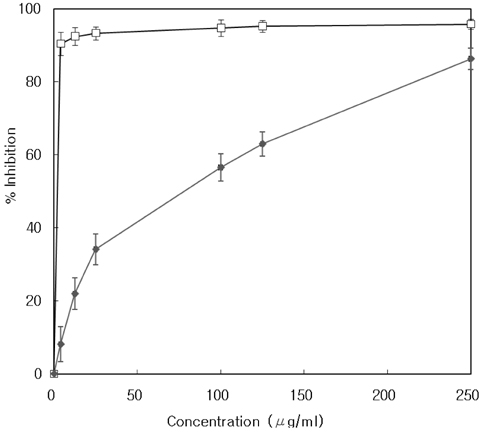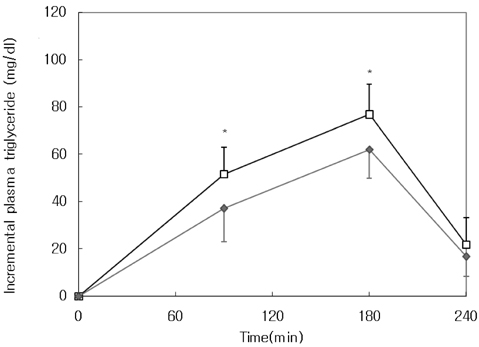Nutr Res Pract.
2008 Dec;2(4):200-203. 10.4162/nrp.2008.2.4.200.
Pancreatic lipase inhibitory activity of taraxacum officinale in vitro and in vivo
- Affiliations
-
- 1Department of Nutrition and Food Science, Auburn University, AL 36849, USA.
- 2School of Food and Life Science, Biohealth Product Research Center, Institute for Food Sciences, Inje University, 607 Obang-dong, Gimhae, Gyeongnam 621-749, Korea. cha8@chonbuk.ac.kr
- KMID: 2139192
- DOI: http://doi.org/10.4162/nrp.2008.2.4.200
Abstract
- Obesity has become a worldwide health problem. Orlistat, an inhibitor of pancreatic lipase, is currently approved as an anti-obesity drug. However, gastrointestinal side effects caused by Orlistat may limit its use. In this study the inhibitory activities of dandelion (Taraxacum officinale) against pancreatic lipase in vitro and in vivo were measured to determine its possible use as a natural anti-obesity agent. The inhibitory activities of the 95% ethanol extract of T. officinale and Orlistat were measured using 4-methylumbelliferyl oleate (4-MU oleate) as a substrate at concentrations of 250, 125, 100, 25, 12.5 and 4 microgram/ml. To determine pancreatic lipase inhibitory activity in vivo, mice (n=16) were orally administered with corn oil emulsion (5 ml/kg) alone or with the 95% ethanol extract of T. officinale (400 mg/kg) following an overnight fast. Plasma triglyceride levels were measured at 0, 90, 180, and 240 min after treatment and incremental areas under the response curves (AUC) were calculated. The 95% ethanol extract of T. officinale and Orlistat, inhibited, porcine pancreatic lipase activity by 86.3% and 95.7% at a concentration of 250 microg/ml, respectively. T. officinale extract showed dose-dependent inhibition with the IC50 of 78.2 microg/ml. A single oral dose of the extract significantly inhibited increases in plasma triglyceride levels at 90 and 180 min and reduced AUC of plasma triglyceride response curve (p<0.05). The results indicate that T. officinale exhibits inhibitory activities against pancreatic lipase in vitro and in vivo. Further studies to elucidate anti-obesity effects of chronic consumption of T. officinale and to identify the active components responsible for inhibitory activity against pancreatic lipase are necessary.
Keyword
MeSH Terms
Figure
Reference
-
1. Arai I, Amagaya S, Komatsu Y, Okada M, Hayashi T, Kasai M, Arisawa M, Momose Y. Improving effects of the extracts from Eugenia uniflora on hyperglycemia and hypertriglyceridemia in mice. J Ethnopharmacol. 1999. 68:307–314.
Article2. Aronne LJ. Modern medical management of obesity: the role of pharmaceutical intervention. J Am Diet Assoc. 1998. 98:S23–S26.3. Ballinger A, Peikin SR. Orlistat: its current status as an anti-obesity drug. Eur J Pharmacol. 2002. 440:109–117.
Article4. Birari RB, Bhutani KK. Pancreatic lipase inhibitors from natural sources: unexplored potential. Drug Discov Today. 2007. 12:879–889.
Article5. Bisset NG. Taraxaci radix cum herba. Herbal Drugs and Phytopharmaceuticals, Medpharm. 1994. Germany: Stuttgart;486–489.6. Cho SY, Park JY, Oh YJ, Jang JY, Park EM, Kim MJ. Effect of dandelion leaf extracts on lipid metabolism in rats fed high cholesterol diet. J Korean Soc Food Sci Nutr. 2000. 29:676–682.7. Cho SY, Park JY, Park EM, Choi MS, Lee MK, Jeon MJ, Jang MK, Kim MJ, Park YB. Alternation of hepatic antioxidant enzyme activities and lipid profile in streptozotocin-induced diabetic rats by supplementation of dandelion water extract. Clin Chim Acta. 2002. 317:109–117.
Article8. Cho SY, Oh YJ, Park JY, Lee MK, Kim MJ. Effect of dandelion (Taraxacum officinale) leaf extracts on hepatic antioxidative system in rats fed high cholesterol diet. J Korean Soc Food Sci Nutr. 2003. 32:458–463.9. Han LK, Kimura Y, Kawashima M, Takaku T, Taniyama T, Hayashi T, Zheng YN, Okuda H. Anti-obesity effects in rodents of dietary teasaponin, a lipase inhibitor. Int J Obes Relat Metab Disord. 2001. 25:1459–1464.
Article10. Han LK, Zheng YN, Xu BJ, Okuda H, Kimura Y. Saponins from Platycodi Radix ameliorate high fat diet-induced obesity in mice. J Nutr. 2002. 132:2241–2245.
Article11. Hochuli E, Kupfer E, Maurer R, Meister W, Mercadal Y, Schmidt K. Lipstatin, an inhibitor of pancreatic lipase, produced by Streptomyces toxytricini. II. Chemistry and structure elucidation. J Antibiot (Tokyo). 1987. 40:1086–1109.
Article12. Hu C, Kitts DD. Dandelion (Taraxacum officinale) flow extract suppresses both reactive oxygen species and nitric oxide and prevents lipid oxidation in vitro. Phytomedicine. 2005. 12:588–597.
Article13. Jandacek RJ, Woods SC. Pharmaceutical approaches to the treatment of obesity. Drug Discov Today. 2004. 15:874–880.
Article14. Juhel C, Armand M, Pafumi Y, Rosier C, Vandermander J, Lairon D. Green tea extract (AR25) inhibits lipolysis of triglycerides in gastric and duodenal medium in vitro. J Nutr Biochem. 2000. 11:45–51.
Article15. Karamanos BG, Thanopoulou AC, Roussi-Penesi DP. Maximal post-prandial triglyceride increases reflects post-prandial hypertriglyceridaemia and is associated with the insulin resistance syndrome. Diabet Med. 2001. 18:32–39.
Article16. Kim HY. Effect of onion (Allium cepa) skin extract on pancreatic lipase and body weight-related parameters. Food Science and Biotechnology. 2007. 16:434–438.17. Kurihara H, Asami S, Shibata H, Fukami H, Tanaka T. Hypolipemic effect of Cyclocarya paliurus (Batal) Iljinskaja in lipid-loaded mice. Biol Pharm Bull. 2003. 26:383–385.
Article18. Kurihara H, Shibata H, Fukui Y, Kiso Y, Xu JK, Yao XS, Fukami H. Evaluation of the hypolipidemic property of Camellia sinensis Var. ptilophylla on postprandial hypertriglyceridemia. J Agric Food Chem. 2006. 54:4977–4981.
Article19. Mascolo N, Autore G, Capasso F, Menghini A, Fasulo MP. Biological screening of Italian medical plants for anti-inflammatory activity. Phytother Res. 1987. 1:28–31.
Article20. Mokdad AH, Ford ES, Bowman BA, Dietz WH, Vinicor F, Bales VS, Marks JS. Prevalence of obesity, diabetes, and obesity-related health risk factors. JAMA. 2003. 289:76–79.
Article21. Moreno DA, Ilic N, Poulev A, Brasaemle DL, Fried SK, Raskin I. Inhibitory effects of grape seed extract on lipases. Nutrition. 2003. 19:876–879.
Article22. Moreno DA, Ripoll C, Ilic N, Poulev A, Aubin C, Raskin I. Inhibition of lipid metabolic enzymes using Mangifera indica extracts. J Food Agric Environ. 2006. 4:21–26.23. Olshansky SJ, Passaro DJ, Hershow RC, Layden J, Carnes BA, Brody J, Hayflick L, Butler RN, Allison DB, Ludwig DS. A potential decline in life expectancy in the United States in the 21st century. N Engl J Med. 2005. 352:1135–1137.24. Shin JE, Han MJ, Kim DH. 3-Methylethergalangin isolated from Alpinia officinarum inhibits pancreatic lipase. Biol Pharm Bull. 2003. 26:854–857.
Article25. Thompson ABR. Disturbance in lipid metabolism. 1978. New York, USA: American Physiological Society;31.26. Weibel EK, Hadvary P, Hochuli E, Kupfer E, Lengsfeld H. Lipstatin. An inhibitor of pancreatic lipase, produced by Streptomyces toxytricini. I. Producing organism, fermentation, isolation and biological activity. J Antibiot (Tokyo). 1987. 40:1081–1085.
Article27. Weigle DS. Pharmacological therapy of obesity: past, present, and future. J Clin Endocrinol Metab. 2003. 88:2462–2469.
Article28. Williams CA, Goldstone F, Greenham J. Flavonoids, cinnamic acids and coumarins from the different tissues and medical preparations of Taraxacum officinale. Phytochemistry. 1996. 42:121–127.
Article29. Yamamoto M, Shimura S, Itoh Y, Ohsaka T, Egawa M, Inoue S. Anti-obesity effects of lipase inhibitor CT-II, an extract from edible herbs, Nomame Herba, on rats fed a high-fat diet. Int J Obes Relat Metab Disord. 2000. 24:758–764.
Article
- Full Text Links
- Actions
-
Cited
- CITED
-
- Close
- Share
- Similar articles
-
- In Vitro α-Amylase, α-Glucosidase, Pancreatic Lipase, Xanthine Oxidase Inhibiting Activity of Agaricus bisporus Extracts
- Extraction and Characteristics of Anti-obesity Lipase Inhibitor from Phellinus linteus
- Hyperlipidemic Inhibitory Effects of Phellinus pini in Rats Fed with a High Fat and Cholesterol Diet
- Evaluation of the Clinical Usefulness for Pancreatic Amylase in Acute Pancreatitis
- Changing patterns of Pancreatic enzyme after Distal Gastrectomy and the Effect of Protease Inhibitor Treatment



